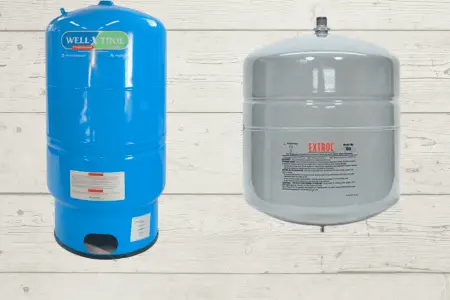The world of plumbing can be confusing with all the different terms, tools, and technology. One of the most puzzling things for homeowners is choosing between an expansion tank and a pressure tank. They look and operate similarly, so what’s the difference and which one is best for you?
The biggest difference between pressure tanks and expansion tanks is in where they’re used. Expansion tanks are installed above a water heater and help to protect it when hot water expands. Pressure tanks are installed near your well pump and help to protect and extend its lifespan.
While these plumbing components is similar, they are not interchangeable. In this article, we’ll take a deeper look at both expansion tanks and pressure tanks. We’ll also help you determine which one you need, if you need any, or if you need both.
What is the Purpose of Having an Expansion Tank?
Expansion tanks are designed to relieve water pressure that’s created from hot water. When hot water is created it expands which results in higher pressure within the water heater. That extra pressure needs somewhere to go, which is where the expansion tank comes into play.
Whether or not you need an expansion tank is largely dependent on how your plumbing system is set up. In years past, plumbing systems were set up as an “open-loop” system, which means that excess water pressure could travel through your water pipes and into the city water supply. However, most newer communities have started installing check valves in their water systems.
Check valves essentially close the water pipes after water enters the house, which means that pressure gets trapped and isn’t able to flow backward into the city water supply. This means that the pressure created by hot water expanding is now trapped in your water heater and the surrounding water pipes.
Risks of Not Having an Expansion Tank
- Damage to Your Water Heater
The first and most likely thing to get damaged due to water expansion is your water heater. I’ve seen firsthand what happens to water heaters that don’t have an expansion tank installed above them. The sides and tops of the tank bulge outward and eventually burst open because of the excess pressure.
- Damage to the Pressure Relief Valve
If the water heater doesn’t get damaged, your pressure relief valve probably will. The pressure relief valve is attached to the water heater and is designed to open up and relieve pressure when it gets too high. However, it’s possible that the valve fails under extreme pressure and gets damaged.
- Damage to Your Appliance Valves
Each of your toilets and washing machines has solenoid valves installed on them. If the pressure gets too high within your plumbing system, it’s possible that they become damaged and water will flow uncontrollably through them.
What is the Purpose of Having a Pressure Tank?
Pressure tanks are designed to protect and extend the life of your well pump by reducing the number of cycles it has to go through. Reducing the number of cycles helps increase the lifespan of the pump by making it work less than it would otherwise have to. Pressure tanks also store up water that can be sent throughout your house during periods of time when the pump is between cycles. This also reduces the number of cycles on the pump.
There are also times when your well pump isn’t able to keep up with the water demands of your home. The pressure tank has stored up water that it can send downstream to aid in water demand, which is critical for large households. All in all, pressure tanks are extremely important to well pumps and will reduce the number of problems and maintenance the pump has to go through.
As you can see, pressure tanks and expansion tanks are both designed to protect certain parts of your plumbing system. Expansion tanks protect your water heater, pressure relief valves, and solenoid valves in your appliances. Pressure tanks protect and prolong the lifespan of your well pump, which is one of the costliest components in your plumbing system.
Do I Need an Expansion Tank if I Have a Pressure Tank?
Despite having similar names and appearances, expansion tanks and pressure tanks have nothing to do with one another. Expansion tanks help your water heater while pressure tanks help your well pump.
If you have an open-loop plumbing system where there isn’t a check valve installed on your water supply, you don’t always need an expansion tank. However, depending on where you live, expansion tanks are required by building code, especially if you have a closed-loop system.
Pressure tanks aren’t necessarily required, but they’re fairly standard on newer homes. Pressure tanks improve the function and lifespan of your well pump, which is extremely important to your plumbing system.
Do you live in a colder climate and worry about your pressure tank freezing? Check out this article to learn what to do.
Will an Expansion Tank Increase Water Pressure?
Something that people often worry about with expansion tanks is a sudden increase in water pressure. However, because expansion tanks are designed to accommodate the extra pressure that hot water creates, they’re able to mix air and water in a way that doesn’t significantly increase water pressure.
The expansion tank is initially full of air. As the hot water from your water heater expands, the expansion tank fills with a mixture of air and water. The air compresses as water takes its place, which is what enables the relatively little increase in water pressure.
What Can I Use Instead of an Expansion Tank?
If you don’t want the hassle and cost of installing an expansion tank, there may be another option for you. Thermal expansion relief valves are becoming a popular alternative to expansion tanks. Expansion tanks commonly experience problems such as pinhole leaks, condensation issues, and costly installation.
Want to know the difference between thermal expansion relief valves and expansion tanks? Read this article to find out more.
Thermal expansion relief valves are smaller, less maintenance, and cheaper to install. Rather than storing up excess pressure inside of a tank, relief valves open up and release the extra pressure into the air. Make sure that you check your local building code to find out if relief valves are an option as opposed to an expansion tank.
FAQ
What are the cost and expected lifespan of pressure tanks?
Pressure tanks cost anywhere from $250 to $2,000 depending on their size and quality. They have an expected lifespan of 4 to 7 years.
What are the cost and expected lifespan of expansion tanks?
Expansion tanks cost $250 to $550 to purchase and install and are expected to last anywhere from 5 to 10 years.
Final Thoughts
Pressure tanks and expansion tanks play an extremely important role within your plumbing system. Pressure tanks should be installed on all plumbing systems to protect and maintain your well pump. Expansion tanks aren’t always necessary but can save you thousands of dollars in repairs and potential damages. You should check with a plumbing professional if you think you need one or both of these tanks.

Nick Lopresti is the founder of YourH2Home and a home improvement expert. He has years of experience writing about various home improvement topics, mostly as it pertains to water systems.
